Related Research Articles
A bunker buster is a type of munition that is designed to penetrate hardened targets or targets buried deep underground, such as military bunkers.

The M-28 or M-29 Davy Crockett Weapon System was a tactical nuclear recoilless smoothbore gun for firing the M388 nuclear projectile, armed with the W54 nuclear warhead, that was deployed by the United States during the Cold War. It was the first, and, at the time, the most important project assigned to the United States Army Weapon Command in Rock Island, Illinois. It remains one of the smallest nuclear weapon systems ever built, with a yield of 20 tonnes of TNT (84 GJ). It is named after American folk hero, soldier, and congressman Davy Crockett.

The B61 nuclear bomb is the primary thermonuclear gravity bomb in the United States Enduring Stockpile following the end of the Cold War. It is a low to intermediate-yield strategic and tactical nuclear weapon featuring a two-stage radiation implosion design.
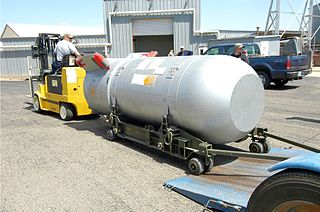
The Mk/B53 was a high-yield bunker buster thermonuclear weapon developed by the United States during the Cold War. Deployed on Strategic Air Command bombers, the B53, with a yield of 9 megatons, was the most powerful weapon in the U.S. nuclear arsenal after the last B41 nuclear bombs were retired in 1976.

The B28, originally Mark 28, was a thermonuclear bomb carried by U.S. tactical fighter bombers, attack aircraft and bomber aircraft. From 1962 to 1972 under the NATO nuclear weapons sharing program, American B28s also equipped six Europe-based Canadian CF-104 squadrons known as the RCAF Nuclear Strike Force. It was also supplied for delivery by UK-based Royal Air Force Valiant and Canberra aircraft assigned to NATO under the command of SACEUR. In addition, certain U.S. Navy carrier based attack aircraft such as the A3D Skywarrior, A4D Skyhawk, and A3J Vigilante were equipped to carry the B28.
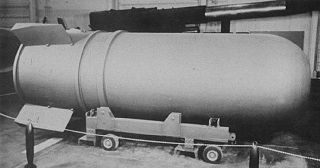
The B-41 was a thermonuclear weapon deployed by the United States Strategic Air Command in the early 1960s. It was the most powerful nuclear bomb ever developed by the United States, with a maximum yield of 25 megatons of TNT. The B-41 was the only three-stage thermonuclear weapon fielded by the U.S.
Laydown delivery is a mode of delivery found in some nuclear gravity bombs: the bomb's descent to the target is slowed by parachute so that it lands on the ground without detonating. The bomb then detonates by timer some time later. Laydown delivery requires the weapon to be reinforced so that it can survive the force of impact.

An air burst or airburst is the detonation of an explosive device such as an anti-personnel artillery shell or a nuclear weapon in the air instead of on contact with the ground or target. The principal military advantage of an air burst over a ground burst is that the energy from the explosion is distributed more evenly over a wider area; however, the peak energy is lower at ground zero.
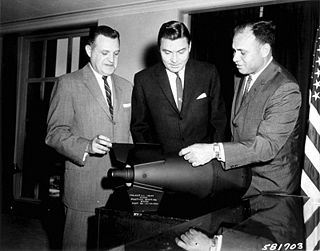
The W54 was a tactical nuclear warhead developed by the United States in the late 1950s. The weapon is notable for being the smallest nuclear weapon in both size and yield to have entered US service. It was a compact implosion device containing plutonium-239 as its fissile material and in its various versions and mods had a yield of 10 to 1,000 tons of TNT.
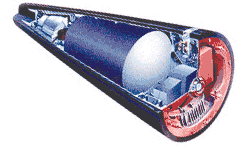
The W76 is a United States thermonuclear warhead, designed for use on the UGM-96 Trident I sea-launched ballistic missiles (SLBMs) and subsequently moved to the UGM-133 Trident II as Trident I was phased out of service. The first variant, the W76 mod 0 (W76-0) was manufactured from 1978 to 1987, and was gradually replaced by the W76 mod 1 (W76-1) between 2008 and 2018, completely replacing the Mod 0 in the active stockpile. In 2018 it was announced that some Mod 1 warheads would be converted to a new low-yield W76 mod 2 (W76-2) version. The first Mod 2 warheads were deployed in late 2019.

Mark 7 "Thor" was the first tactical fission bomb adopted by US armed forces. It was also the first weapon to be delivered using the toss method with the help of the low-altitude bombing system (LABS). The weapon was tested in Operation Buster-Jangle. To facilitate external carry by fighter-bomber aircraft, Mark 7 was fitted with retractable stabilizer fins. The Mark 7 warhead (W7) also formed the basis of the 30.5 inches (775 mm) BOAR rocket, the Mark 90 Betty nuclear depth charge, MGR-1 Honest John rocket, and MGM-5 Corporal ballistic missile. It was also supplied for delivery by Royal Air Force Canberra aircraft assigned to NATO in Germany under the command of SACEUR. This was done under the auspices of Project E, an agreement between the United States and the UK on the RAF carriage of US nuclear weapons. In UK use it was designated 1,650 lb. H.E. M.C. The Mark 7 was in service from 1952 to 1967(8) with 1700–1800 having been built.

The W87 is an American thermonuclear missile warhead formerly deployed on the LGM-118A Peacekeeper ("MX") ICBM. 50 MX missiles were built, each carrying up to 10 W87 warheads in multiple independently targetable reentry vehicles, and were deployed from 1986 to 2005. Starting in 2007, 250 of the W87 warheads from retired Peacekeeper missiles were retrofitted onto much older Minuteman III missiles, with one warhead per missile.

The W48 was an American nuclear artillery shell, capable of being fired from any standard 155-millimetre (6.1 in) howitzer. A tactical nuclear weapon, it was manufactured starting in 1963, and all units were retired in 1992. It was known as the XM454 AFAP in US service.
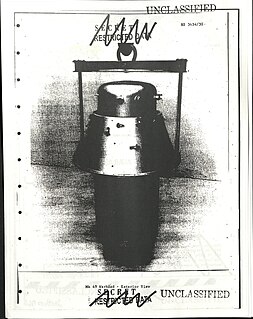
The W49 was an American thermonuclear warhead, used on the Thor, Atlas, Jupiter, and Titan I ballistic missile systems. W49 warheads were manufactured starting in 1958 and were in service until 1965, with a few warheads being retained until 1975.

The W68 warhead was the warhead used on the UGM-73 Poseidon SLBM missile. It was developed in the late 1960s at Lawrence Livermore National Laboratory.

The W56 was an American thermonuclear warhead produced starting in 1963 which saw service until 1993, on the Minuteman I and II ICBMs.

The Mark 4 nuclear bomb was an American implosion-type nuclear bomb based on the earlier Mark 3 Fat Man design, used in the Trinity test and the bombing of Nagasaki. With the Mark 3 needing each individual component to be hand-assembled by only highly trained technicians under closely controlled conditions, the purpose of the Mark 4 was to produce an atomic weapon as a practical piece of ordnance. The Mark 4 Mod 0 entered the stockpile starting March 19, 1949 and was in use until 1953. With over 500 units procured, the Mark 4 was the first mass-produced nuclear weapon.
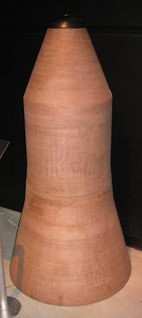
The W59 was an American thermonuclear warhead used on some Minuteman I ICBM missiles from 1962 to 1969, and planned to be used on the cancelled GAM-87 Skybolt air-launched ballistic missile.

The W73 was a planned nuclear warhead for the AGM-53 Condor air to surface missile and designed by Los Alamos Scientific Laboratory. The W73 warhead was cancelled in 1970 in favor of a purely conventional warhead for Condor. Condor was approved for production in 1975 with a expected production run of 250 missiles, but was cancelled in early 1976 due to high cost.
The B61 Family is a series of nuclear weapons based on the B61 nuclear bomb.
References
- 1 2 National Research Council (2005). Effects of Nuclear Earth-Penetrator and Other Weapons. National Academies Press. ISBN 9780309096737. Archived from the original on 2021-05-15. Retrieved 2021-03-29.
- 1 2 History of the Mk28 (Report). Sandia National Laboratories. August 1968. Archived from the original on 2021-07-07. Retrieved 2021-03-29.
- ↑ History of the TX-61 Bomb (Report). Sandia National Laboratories. August 1971. Archived from the original on 2021-03-30. Retrieved 2021-03-29.
- ↑ History of the Mk52 Warhead (Report). Sandia National Laboratories. January 1968. Archived from the original on 2021-09-01. Retrieved 2021-03-29.
- ↑ History of the Mk50 Warhead (Report). Sandia National Laboratories. January 1968. Archived from the original on 2021-09-01. Retrieved 2021-03-29.